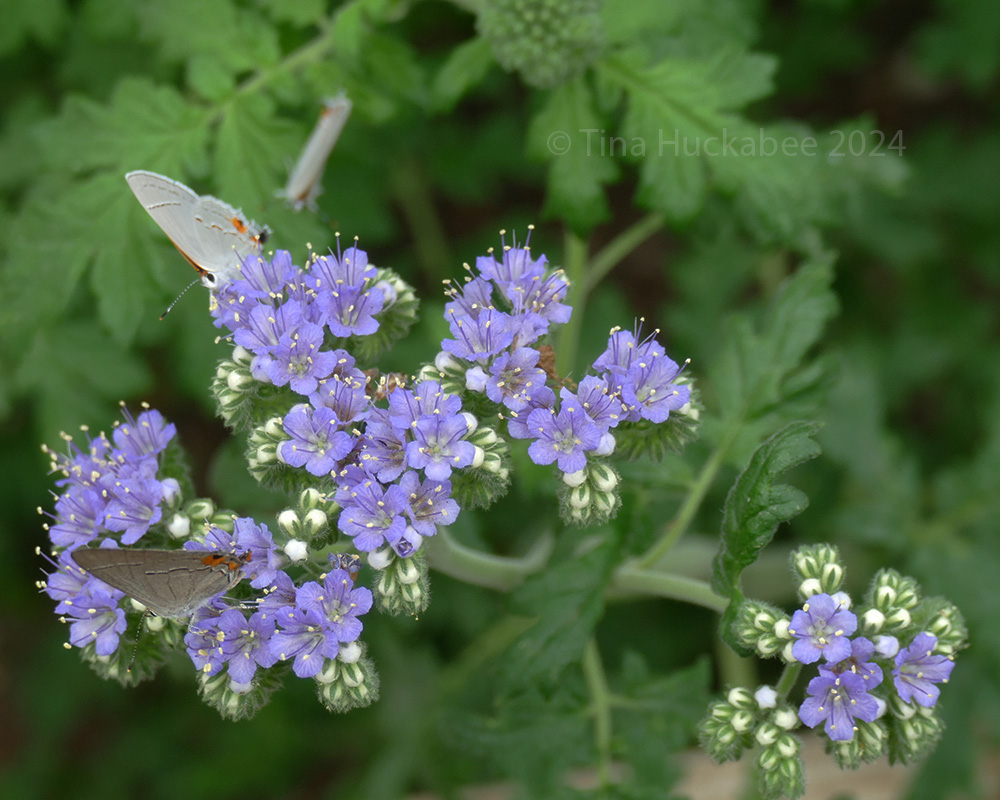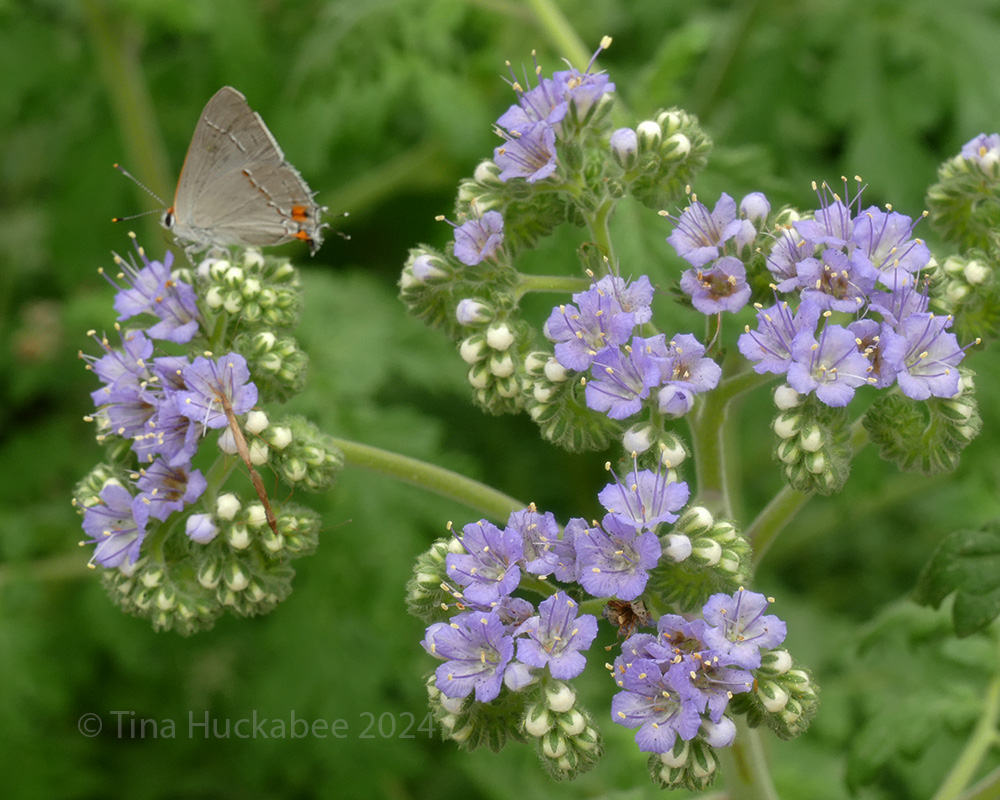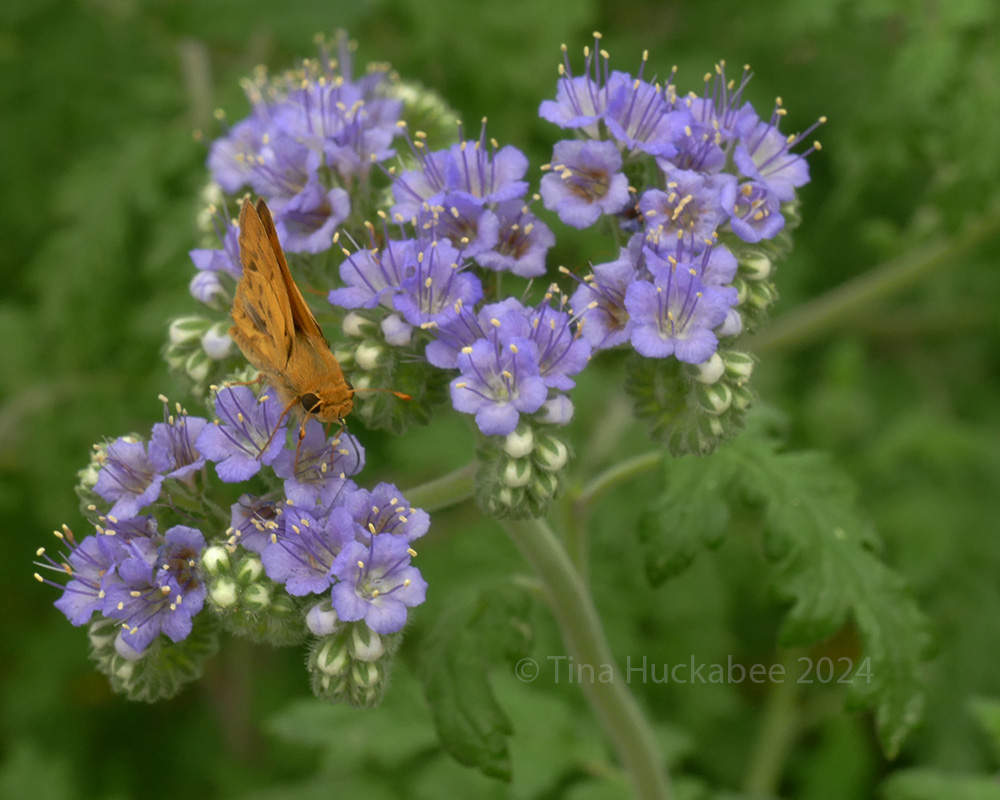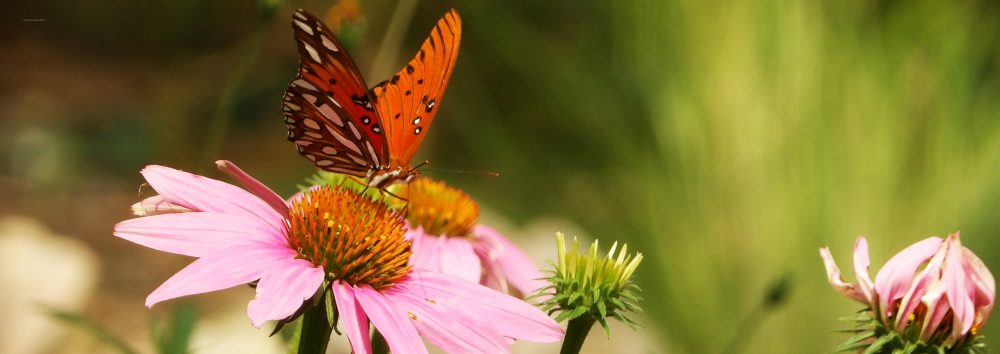Like peanut butter-n-jelly or mac-n-cheese, butterflies-n-wildflowers form a classic pair. My personal aphorism defining wildlife gardening is, if you plant them (wildflowers), they (pollinators) will come. This proves especially resonant in a spring season with ample rain followed by generous sunshine.
Blue Curls or Caterpillars, Phacelia congesta, bloom beautifully from March through May, attracting a huge variety of pollinators to the blue/purple flowers, which unfurl along a cluster as the diminutive flowers open. Pollinators, especially butterflies, are ga-ga for Blue Curls’ bounty. Sunny days bring fluttery life to the space above and around blooming Blue Curls, all manner of winged things in constant movement. Other pollinators, like beetles and true bugs, reach the pretty little flowers through multi-legged walk-a-bouts.
Here, two Grey Hairstreaks nectar on the flowers while another waits in the background. Maybe that one is full of rich nectar, and sits, resting and digesting.

This hairstreak feeds, but is it alone?

Looking directly down from the small butterfly, another pollinator (a walking stick type insect or a nymph of some sort?) seemingly sips from a flower. I didn’t see this insect when I snapped the shot, only noticing once I downloaded the photo to my laptop. I scrolled through pages of iNaturalist Austin, but there are a gazillion insects listed and I don’t have the time to suss out this guy’s identity. Any suggestions as to what this well-camouflaged critter might be?
Monarchs migrated through Austin, though few visited my gardens. A Blue Curls cluster beckons, a Monarch cousin–the Queen butterfly–alights, nectars and pollinates.

Smaller butterflies like hairstreaks, skippers, metalmarks, and sulphurs frequent Blue Curls, often alongside other pollinators, all sharing dining on a given cluster of flowers. In particular, Fiery Skippers, like Grey Hairstreaks, are abundant.
I think this Fiery Skipper’s coloring complements its Blue Curls meal.

Native bees, especially the tiny Lasioglossum, or sweat bees, also favor Blue Curls. Flies of various sorts cavort amongst the Curls.
This Horace’s Duskywing, a rare find in my garden, provides a dramatic contrast with its Blue Curl plant of choice.

Blue Curls are annuals, living their full life cycle in one year: seeds; germinated seedlings; mature plants with flowers; seeds, once again, after flowers are finished. My Curls are past their peak of blooming, beginning their seed production. I’ll leave the individual plants until the seed heads are brown, then I’ll prune the stalks to the ground and shake all available seeds into the garden for next year’s crop. The Blue Curl seeds (as well as other perennial and annual seeds) are currently providing meals for migratory birds. I’ve observed Lincoln Sparrows, Common Yellowthroats, Clay-colored Sparrows, Yellow Warblers, and Painted Buntings eating from these plants in the last few weeks. Seeds and insects on plants make up most of migratory birds’ meals.

Once the Blue Curls of 2024 are history (aside from their dormant seeds snoozing on the soil), the heat-loving summer perennials and annuals will step up to provide cover and sustenance for bees, birds, butterflies, and other garden critters.
The cycle continues, unbroken, in a native plants, wildlife-friendly garden.

I’d have expected blue curls in our area to be done by now, in accord with what you mentioned about the ones in your yard being past their peak, and yet I recently found fresh ones still budding and therefore presumably still bearing flowers (like those at the bottom of your last photograph beneath the elongated dried-out ones). You’ve certainly gotten your “money’s worth” from them in the form of the many butterflies your photographs show on them.
LikeLike
Blue curls area like so many of the other native plants: they’re still blooming while the rest of the plant is dying or dormant. I usually have to just pull the suckers up, blooms be damned!
I’ve more than gotten my money’s worth as my original starts were given to me from a friend. Free plants are the best!
LikeLike
Lovely to see so much butterfly life in your garden, that plant is obviously a winner.
LikeLike
Thanks, Brian–it really is a winner!
LikeLike
Such a beautiful as well as useful annual. I’ve only grown it once and was disappointed that it didn’t self sow. Maybe too cold here over winter? I loved seeing all your butterfly visitors!
LikeLike
I’m sorry you didn’t get any seedlings; I could imagine that it’s too cold for you. Its native range is in much warmer climates.
LikeLiked by 1 person
It’s beautifully obvious that you DID plant and they DID come, Tina. 😊
On behalf of all the pollinators, thank you for creating such a welcoming place with a free buffet during all seasons.
LikeLike
I just love to see all the action in the garden. My front garden really has so much bee, butterfly, and bird activity, as it’s now full sun with lots blooming. Such fun! (although, it’s super hot… 😦 )
LikeLiked by 1 person
Wishing for less heat and more insects and birds!
LikeLiked by 1 person
I’ve been looking for some nice annuals that will re-seed, and Blue Curls sounds perfect. Thanks!
LikeLike
Good luck with them! If they’re happy, you’ll be happy too!
LikeLike
These are among my favorite flowers. I’ve seen them everywhere from the Rockport cemetery to a vacant lot in Yoakum to Goliad’s Fannin Monument. A Kerrville friend who started some decades ago now has them all over her property, even in dappled shade near some outbuildings. Only half-joking, she says she enjoys sitting in the afternoon and watching them uncurl. They’re not that fast, but they’re fast (and welcoming enough) for all those pollinators!
LikeLike
The Blue Curls really are such great spring wildflowers. Like your friend, it seems like one could, with a nice glass of tea in hand, sit and watch the curls unfurl!
LikeLiked by 1 person
Lovely post, as always. I believe that is a Queen not a Monarch on the Blue Curls.
LikeLike
You’re correct! I just took a quick look and since the monarchs had been through the garden (though not many) and I hadn’t seen any queens, I didn’t double check–good catch!
LikeLike